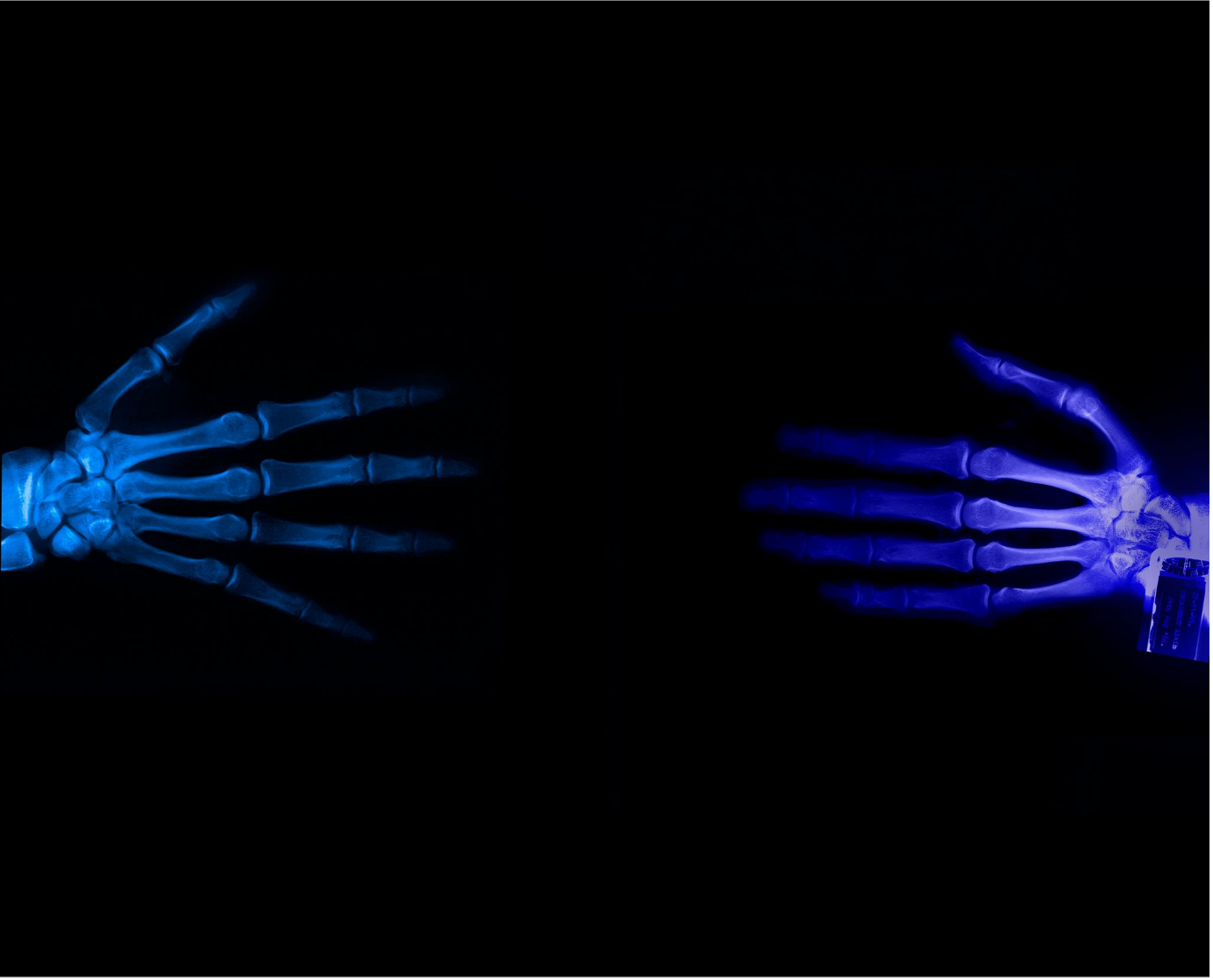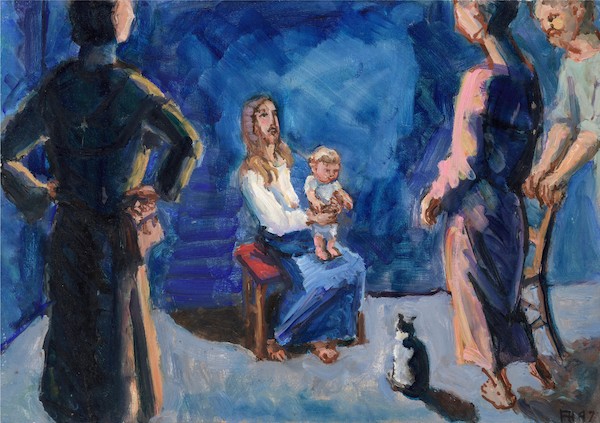Jan van Goyen is one of the most brilliant landscape painters of all time. He was productive between 1620 and 1656, the year of his death. His art improved in a direct line, and the works he made after 1640 are virtually all masterpieces. We shall discuss one of his paintings from 1646,

Jan van Goyen is almost unrivalled as a master of representing space. He was in complete command of the devices that had been developed for this since the beginning of the modern period, and he applied them brilliantly. In the first place there is his perspective – figures appear smaller the further away they are from us – but possibly even more important is his atmospheric perspective – the tone and colour of an object that is further from us is lighter and softer than that of a similar object viewed at closer range (compare the sails of the boats in this painting). He also uses repoussoir – setting a lighter object against a dark background or a darker object against a light background so that it thereby appears to be located to the fore while the background is pushed back (repousser). And, finally, he uses lighter and darker strokes in the water so that a clear spatial arrangement is achieved and things are put in their right place, as it were. In this painting we see the repoussoir in the sails as they stand out against the sky but also in the dark boat set against the lighter strip of water, which is thereby clearly pushed back. Through that repoussoir the artist can make things clear and define them distinctly in their interconnectedness. Jan van Goyen knows how to use this device in such a way that we hardly notice it, it seems so natural. Only upon looking more closely do we discover the mastery and realize that it is not a simple matter of course.
It is remarkable how the painter is able to use the darkly clouded sky to draw our eye towards the back, where the lightest part of the painting is at the most distant horizon. In the clouds too one can point out repoussoir (one against the other). Yet it is still more remarkable when we come to realize just what van Goyen accomplishes with the clouds, how he divides them as dark tones across the flat surface to thereby reinforce the entire construction of his composition.
With that we have arrived at the real problem, which led us to select this painting for discussion which at first glance may appear to be just another representation of a scene one could have witnessed any time, and possibly still can, somewhere in the Netherlands along one of the great rivers or the former Zuiderzee or Haarlemmermeer. For Jan van Goyen knew, perhaps better than anyone else, that a painting is in the first place a flat surface on which we work with our painting materials to call up our picture. In spite of the fact that he knew infallibly how to usethe depth-depicting devices we have described, the syntax of his times, one can never accuse him, as some modern artists have reproached the old masters for doing, of tricking us by suggesting a ‘hole in the wall’, namely a real depth. On the contrary, Jan van Goyen knew not only how to maintain the surface but also how to use it in a wonderful way to serve his purposes.
Van Goyen’s compositions are very tightly constructed and guided by an almost symphonic feel for form. Left . . . yes, one ‘reads’ a painting from left to right. This probably is because of the direction in which we write (and it would therefore be the reverse for, e.g. Chinese people). Naturally we can look at a painting from right to left or in any other way, but only after we have read it in the right direction first. In a similar way we have to read a sonnet first from top to bottom, and only after we have done that can we go back and re-read one line or another, and figure out how the way the sonnet ends is prepared and called up in earlier lines.
The correct order of reading is presupposed in the creative process. But to return to our earlier discussion: at the left of the landscape we see the ‘introduction’ by means of a little boat, which draws us into the space and positions us on the water, as it were. Then we come to the first theme, which we could call ‘distance with storm cloud’. Next we have the transitional theme in the pair of slightly larger sailboats, precisely in the middle of the canvas. Following that we come to the second main theme: ships tied up at a mooring, at a harbour, suggested by a few houses entirely to the right, which at the same time form the light coda. The main element in the second theme is the ship with the large dark sail, which finds its direct ‘response’ in the somewhat smaller and lighter sail just behind it. That second theme is more loaded, busier and manifests more movement, and it fixes our eye on a less remote distance parallel to the surface of the painting.
And now, if we look at the clouds again, we see that, like a kind ofcountermelody, a bass line, they follow the themes, and so also the main organizing principle of the painting. Thus the ‘reading direction’ from left to right is anything but arbitrary. We cannot turn this painting around – just try holding the page up to the light on which it is reproduced here and look at it from the back. It immediately becomes difficult to see the two themes. It is still possible to do so in this case, but much more difficult in many others. That it is still possible here, at least to a degree, is due to the serenity; it is not possible where ships are in motion, with their sails fixing the direction of observation. Typically, the second theme has much more complex, and plural, constructive elements. Moving from left to right, one discovers that matters also often become more complex in a painting. It can be compared in this respect with a novel that begins with a single character but in which gradually an ever larger number of people come to play a part.
In this painting we therefore do not have some kind of copy of reality, not a photograph of what we would have seen had we been there. Rather, we enter another world, the world of the painting. And Jan van Goyen has clearly set the world of painting off from our own world with a ‘threshold’, the dark strip in the foreground.
Thus this world does not offer us exactly what we would have seen in reality with our own eyes, had we been there. Rather, what we have here is Jan van Goyen’s view of what was there, his own poetic view of a slice of reality, his own ‘song’ about the beauty at the calm mouth of a river. The things he notices and shows us are not necessarily self-evident, we must learn to observe them. And if Dutch people today cherish such beauties – and often, happily, they do – then they have to thank for that the lessons in observation that they learned from this artist (and those who followed after him), even if they are not conscious of it and, yes, may indeed never have been personally involved with such art. Once eyes have been opened to something so real and pure, so true, in which there is so much humanity and in which justice is done to all the elements, it is not easily forgotten. Fathers pass it on to their sons.
It is remarkable that this unifying effect, the distinctive quality of this ‘symphonic poem in paint’, arises in the composition. It would carry us too far afield to introduce a great deal of comparative material here. But it is precisely the use of two themes and the other elements we discussed that call forth this effect. By simply drawing a certain view of a wide river we cannot achieve such artistic content and such a suggestive result. It is therefore no surprise, as becomes evident when we examine Jan van Goyen’s works carefully, that the artist seldom stuck closely to a precisely identifiable phenomenon. His art is not topographical, it does not portray exact locations, although he occasionally incorporates a ‘citation’ or visual reference to an existing tower, for example the one in Dordt. What he shows us, rather, is the structure of the landscape, in this case of a river-mouth or a lake, where the beauty forms an integrating part of the whole.
Could this view of reality not have had something to do with the Reformation? Could it be a fruit of our having opened ourselves up once again to reality as we learn to know it in the Bible? The Reformation liberated art from the chains of the domination of church and devotion, and it did so without secularization, without seeing the world as something detached from God. Such a hymn to the unity of creation, in its beauty, in its multiformity, in its richness and intimate connection with humanity – without idealistic exaltation, without making the world a sort of humanistic paradise where one is always on vacation with no difficulty or care – is something we can look at with jealousy today. No, this is no vacation paradise, no world of labourless rest and ‘ideal beauty’; it is much more sober. It is as sober as the music of Heinrich Schütz can be, without frills, direct, and always with complete unity between means and ends.
In a painting like the one we have been discussing there is a complete unity between the iconic elements and the aesthetic structure, such that the content of the work cannot be considered apart from the manner of artistic realization: the theme is not an excuse to paint something, and the composition is not just coincidental, an embellishment of something that could have been said just as well in a few words.
We said that we might be looking here at one of the fruits of the Reformation. The painting reflects the spiritual climate in Holland during the first half of the seventeenth century. And it does so despite the fact that van Goyen was a Roman Catholic. His view is conditioned by the world in which he lived, and the word ‘Counter-Reformation’ has no meaning in connection with this river scene. Nor has it any meaning in connection with the work of van Goyen’s son-in-law Jan Steen. Compare Steen’s art with the art of Rubens and the difference will be even more clear.
Published in Dutch in Kunst en Amusement, Kok – Kampen, 1962.
Published in English in M. Hengelaar-Rookmaaker (ed.): H.R. Rookmaaker:
The Complete Works 3, Piquant – Carlisle, 2003. Also obtainable as a CD-Rom.
%20(1).png)












